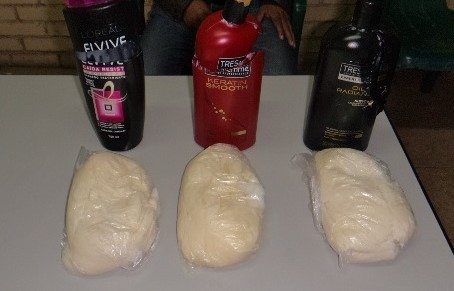By
Ricardo Swire
In early December 2016 Carabiniers of Chile or Federal Police exposed another innovative drug trafficking method.
Three shampoo bottles containing a creamy configuration of cocaine were seized from a forty-nine year old Peruvian bus passenger in northern Chile. He carried the drugs in his suitcase, from Lima to Chilean city La Serena. The intercepted cocaine weighed one 1.75 kilograms, worth 34 million pesos. According to Chile’s Regional Customs Director; “Drugs in this semi solid state are modified chemically to not generate odor.”
Prior to the inventive cream formula, cocaine’s liquid configuration was heralded the favorite unusual method. One preferred cocaine to liquid procedure mixes the white powdery substance with acetone, gasoline or other substitutable solvents. Items of clothing and paper are soaked in the concoction that can also be infused in rice grains for trafficking purposes. Returning liquefied cocaine to powder requires another chemical procedure, a special technique that applies varying degrees of heat, until the solvent evaporates and discards cocaine hydrochloride.
Chile’s counter-narcotics agents routinely monitor Bolivian Aymara Indian backpackers known to move cocaine across borders. The hikers carry a minimum twenty pounds of cocaine paste via Arica town, on Chile’s northern border with Bolivia. Only four control points cover the border’s two hundred miles. Arica’s desert naturally secludes it from the remainder of Chile. Expansive borders, with both Bolivia and Peru, offer the Aymara backpackers approximately two hundred and fifty crossing points. Only seven are controlled by immigration police. Peru’s border is ten miles north of Arica town, marked by single white poles every one thousand yards.
An internal security report itemized cocaine consignments transported by vehicle to southern Chile for chemical conversion. Afterwards the drug is shipped overseas from secret locations along Chile’s border and coastline. Cornered in the southeast extreme of the Americas, between the Andes mountain ranges and Pacific Ocean, Chile is a vital link in the global cocaine business. Prominence was first brought to light after the assassination of a senior Intelligence Officer (IO). The Colonel was lead witness scheduled to testify in a formal national investigation. He was kidnapped, murdered, his shattered skull and body discarded in the remote southeastern San Alfonso, Santiago Metropolitan district.
The high level probe associated Chile’s Army with 370 tons of illegal weaponry, worth more than US$6 million, shipped to Croatia, 542 armaments included Blowpipe brand Surface to Air missiles, Mamba anti-tank missiles, mortars, rockets, grenades and crates of 7.62 mm cartridges. Activity that contravened a standing United Nations (UN) embargo. The unauthorized ordinance, discovered in Budapest, was camouflaged as “humanitarian aid” sent from a Chilean military hospital.
A former Director of Chile’s Secret Police or DINA testified that his boss, an ex-president, amassed a £14 million fortune from cocaine sales to Europe and America. Wearing his military General rank the former Head of State ordered Chile’s Army to construct a cocaine laboratory in Talagante, a rural town twenty-four miles from the capital Santiago. According to the ex-Director’s sworn testimony DINA personnel managed the Talagante Lab that doubled as a chemical weapons facility. The government resource tested Anthrax, Botulism and produced Sarin nerve gas.
Talagante Lab’s chemist primarily blended cocaine with zinc to produce “Coca Negra” or “Black Cocaine.” Cobalt and Ferric Chloride, two virtually undetectable masking chemicals, were mixed at a ratio of forty percent with cocaine hydrochloride, a combination specially formulated to deceive the K9 sniffers, used by counter-narcotics and customs agents in America and Europe. Spain’s National Police Corps discovered a piece of luggage made exclusively from layers of rubbery Black Cocaine.
On September 7 2015 transnational traffickers copied the Chilean marketing prowess. During a combined Colombian/Mexican Federal Police counter-narcotics operation two tons of cocaine, concealed in a shipment of photocopier/printer toner, were confiscated. One thousand and seventy kilos of the drug, packed in forty-eight toner boxes, were found inside Eldorado International Airport’s Cargo Terminal in Bogota, Colombia. The cocaine was mixed with dry, black ink toner powder packaged in labeled plastic bags. Contracted chemists utilized a formula of solvents, such as Methylene Chloride an organic compound, to extract the cocaine’s chemically structured base.



No Comments Yet!
You can be first to comment this post!